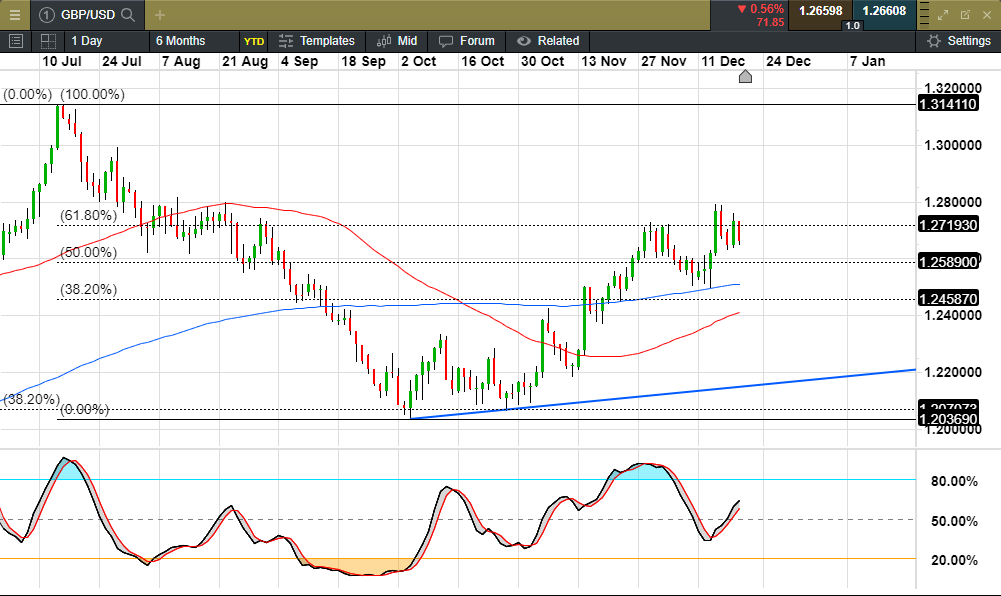
After losing 11.9% of its value against the US dollar in 2022, 2023 has seen a period of consolidation for the pound, and a much more uneventful year than was the case in 2022 when we saw wild swings between highs of 1.3530 and a low point of 1.0350.
Not only did 2022 see its third worst annual decline this century, but the pound also posted a marginal new record low against the greenback, getting pummelled by a trifecta of a meek Bank of England, an aggressive Federal Reserve, and a shambolic domestic political backdrop.
The reality is that 2022 could have been much worse but for a late rebound from the October 2022 lows of 1.0335, which saw a recovery to close the year just above the 1.2000 level.
Putting the broken politics to one side, the UK economy has proven to be much more resilient than was thought to be the case at the end of last year, even accounting for the fact that inflation was still trending at double-digit rates.
At the start of this year the UK base rate was sitting at 3.5%, having risen from 0.25% at the end of 2021, however over the same period the Federal Reserve had raised its own headline rate from 0.25% to 4.5%. This more aggressive change of tack by the Fed signalled that they took the inflation threat much more seriously than the UK central bank which was still parroting the tired line that inflation was transitory, even with headline CPI trending at over 10% since July 2022, and which didn’t fall below this level into March 2023.
Somewhat belatedly the Bank of England woke up to the fact that inflation was likely to be stickier than they originally realised in a move that resulted in several extraordinarily clumsy interventions by Governor Andrew Bailey urging people to exercise wage restraint as surging energy and food prices squeezed consumer budgets to the point of breaking point.
In February the Bank of England decided they needed to continue to raise rates in 50bps increments, however then inexplicably they stopped and started to move in 25bps increments as splits started to emerge on the MPC between the doves who wanted to keep rates on hold at current levels and the hawks who wanted to continue to hike in 50bps increments, recognising that a more aggressive approach was needed in containing rising price pressures, as well as bringing inflation back to target more quickly.
This split between the more dovish approach favoured by the likes of Silvana Tenreyro and Swathi Dhingra who wanted to stop hiking rates, with Tenreyro comparing the hawks on the MPC to “fools in the shower”, who wait until the water gets too hot and get scalded, in comments made in a speech in April. She left the MPC in June and was replaced by Megan Greene who has adopted a more hawkish approach, recognising perhaps that inflation has become much more embedded and that higher rates for longer are needed to squeeze core inflation lower.
These divisions in the early part of the year didn’t help the pound, however when the Bank of England resumed their 50bps hike regime in their June decision it started to become clear that there was some panic that they might overreact to the fact that wages were now starting to rise sharply in response to the fact that inflation wasn’t coming down anywhere near as fast as it was in the US and Europe.
Consequently, markets feared that the Bank of England might have to hike rates even further with swaps markets pricing the prospect of a terminal rate of 6.5% and even higher during the summer months.
This was a classic example of markets getting way over their skis given what such a move would do to an already fragile UK economy, however the sharp rise in gilt yields exercised a squeeze all by itself on the housing market as mortgage rates soared. We also saw the pound rise sharply against the US dollar in July to 1.3140 and its highest level since March 2022.
Since those heady summer months of rising rates which briefly sent UK gilt yields to multi year highs, with the 30-year gilt briefly posting its highest level since 1998, and the UK 10-year yield to 15-year highs, we’ve seen rate expectations hit more realistic levels. For example, we’ve seen the UK 2-year yield slide back from its 5.5% July peak to be trading sharply below 4.5% in a move that has eased the pressure on the fixed rate mortgage market.
This retreat in yields coincided with a recognition that these higher rates were likely to create the very conditions the Bank of England needed to think about slowing down the pace of their rate hike pathway, in a move that saw the central bank unexpectedly signal a hold at 5.25% in September when many had been expecting a 25bp hike.
The delay in inflation falling at the same pace as it has in the US and Europe shouldn’t have been a surprise given that the way the energy price cap was structured meant that the sharp falls in oil and gas prices that we saw at the end of 2022, and most of this year weren’t feeding into consumers’ pockets in the same way.
The problem for the Bank of England and which they have been slow to recognise is that this delay has created the conditions for wages to become stickier than they might have been which in turn has meant that businesses have had to raise prices to cover rising costs.
This will probably mean that rates must stay higher for longer with Bank of England chief economist Huw Pill acknowledging this in a speech in South Africa in August when he called for a “Table Mountain” approach to interest rates.
It is this higher for longer mantra now that was driving markets, having shifted the debate from how many more rate hikes are coming, with the next market narrative now beginning in the form of which central bank will be first to start cutting rates, after this week's November inflation numbers slowed to 3.9%, and the lowest since September 2021.
If we look at the performance of the pound this year, it’s been unremarkable gaining the most against the Japanese yen due to the Bank of Japan’s continually loose monetary policy.
GBP performance year to date 2023

Source: CMC Markets
What’s next for the pound?
As for the rest it’s been much of a muchness, however the next move for the pound is likely to be driven by how well the UK economy performs as we head into 2024, along with how quickly the Bank of England starts to hint at rate cuts, and we aren’t there yet despite this morning’s market reaction to the November inflation numbers, of 3.9%.
Markets are already pricing multiple rate cuts by June of next year due to a weaker economy and lower inflation, however, let’s not forget this time last year, markets were also pricing rate cuts for H2 of this year, and then in the summer markets were pricing in a terminal rate of 6.5%, neither of which transpired.
There is a distinct possibility we could see rate cuts in the coming months, however given that wage growth is currently above 7% and services inflation is 6.3%, it’s unlikely to be the Bank of England which cuts first, unless we see a monumental collapse.
If anything, the central bank most likely to start cutting rates early next year is the European Central Bank, given that there has been no growth in the euro area since Q3 of last year, with inflation there already being lower than in the UK.
So, what does all the above mean for cable or GBPUSD, and EURGBP?
GBPUSD daily chart

Source: CMC Markets
We’ve seen a strong move in the pound from the record lows of October 2022 at 1.0335, peaking at 1.3145 in July this year. Since then, we’ve seen a modest pullback to 1.2035, or the 38.2% Fibonacci retracement of that move. We’ve also got a modest trend line support from those lows, while we are also seeing modest higher highs.
Having risen above the 200-day SMA and briefly extended up to beyond the 1.2730 area which is 61.8% Fibonacci retracement of the down move from the July peaks and October lows the momentum continues to look positive.
Support now comes in at the 200-day SMA as well as 1.2460 which needs to hold to prevent a deeper slide towards 1.2350.
As for EUR/GBP this year has been very much a range trading year as the pound and the euro battle for supremacy in a fashion that has seen it range between 0.8500 and 0.8900.
EUR/GBP daily chart

Source: CMC Markets
Currently in the middle of the 0.8500/0.9000 range, the euro is currently trending higher after sinking to a 1-year low just above 0.8490 in August. The rise in the euro is somewhat counterintuitive given how poor recent economic data has been, especially in Germany and France, however that momentum has started to stall in recent weeks as markets start to price in ECB rate cuts early next year.
We need to see a move through 0.8790 which is a significant resistance for a return to the February peaks at 0.8980.
To conclude the main narrative for 2024 is when are rate cuts likely to start, along with who is likely to be first, and it is this that will drive the next moves in currency markets.
On that basis you could conclude that the US dollar might have the most upside given that it’s likely the Fed will be the last to cut rates given the resilience in the US economy, despite the recent dovish tilt from Powell at the most recent meeting.
The reality might well be different given the recent gains in the US dollar over the last few months, which suggests that this may well already be in the price.
As such any repricing of rate risks might suggest that the US dollar might still have the biggest downside risk even if the Fed is the last to start cutting.
It therefore looks to be a straight contest between the ECB and the Bank of England when it comes to which will cut rates first with markets pricing the first rate cut from the Bank of England by May next year. This could be overpriced given that CPI in the UK is still almost double the rate of that in the EU, even accounting for the recent November numbers slowing to 3.9%, with the energy price cap in January likely to see a tick higher.
As such the odds still favour the ECB being first out of the traps perhaps as soon as the end of Q1 next year, with the Bank of England soon after, which will be good news for households, as well as governments when it comes to debt costs.
Disclaimer: CMC Markets is an execution-only service provider. The material (whether or not it states any opinions) is for general information purposes only, and does not take into account your personal circumstances or objectives. Nothing in this material is (or should be considered to be) financial, investment or other advice on which reliance should be placed. No opinion given in the material constitutes a recommendation by CMC Markets or the author that any particular investment, security, transaction or investment strategy is suitable for any specific person. The material has not been prepared in accordance with legal requirements designed to promote the independence of investment research. Although we are not specifically prevented from dealing before providing this material, we do not seek to take advantage of the material prior to its dissemination.






















